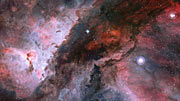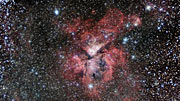Region R44 in the Carina Nebula
Pillars of destruction
Region R18 in the Carina Nebula
Region R37 in the Carina Nebula
Region R45 in the Carina Nebula
Star cluster Trumpler 14
Bok Globule in the Carina Nebula
Mystic Mountain
Videos
Spectacular new observations of vast pillar-like structures within the Carina Nebula have been made using the MUSE instrument on ESO’s Very Large Telescope. The different pillars analysed by an international team seem to be pillars of destruction — in contrast to the name of the iconic Pillars of Creation in the Eagle Nebula, which are of similar nature.
The spires and pillars in the new images of the Carina Nebula
are vast clouds of dust and gas within a hub of star formation about
7500 light-years away. The pillars in the nebula were observed by a team
led by Anna McLeod, a PhD student at ESO, using the MUSE instrument on ESO’s Very Large Telescope.
The great power of MUSE is that it creates thousands of
images of the nebula at the same time, each at a different wavelength of
light. This allows astronomers to map out the chemical and physical
properties of the material at different points in the nebula.
Images of similar structures, the famous Pillars of Creation [1] in the Eagle Nebula and formations in NGC 3603,
were combined with the ones displayed here. In total ten pillars have
been observed, and in so doing a clear link was observed between the
radiation emitted by nearby massive stars and the features of the
pillars themselves.
In an ironic twist, one of the first consequences of the
formation of a massive star is that it starts to destroy the cloud from
which it was born. The idea that massive stars will have a considerable
effect on their surroundings is not new: such stars are known to blast
out vast quantities of powerful, ionising
radiation — emission with enough energy to strip atoms of their
orbiting electrons. However, it is very difficult to obtain
observational evidence of the interplay between such stars and their
surroundings.
<
The team analysed the effect of this energetic radiation on the pillars: a process known as photoevaporation,
when gas is ionised and then disperses away. By observing the results
of photoevaporation — which included the loss of mass from the pillars —
they were able to deduce the culprits. There was a clear correlation
between the amount of ionising radiation being emitted by nearby stars,
and the dissipation of the pillars.
This might seem like a cosmic calamity, with massive stars
turning on their own creators. However the complexities of the feedback
mechanisms between the stars and the pillars are poorly understood.
These pillars might look dense, but the clouds of dust and gas which
make up nebulae are actually very diffuse. It is possible that the
radiation and stellar winds from massive stars actually help create
denser spots within the pillars, which can then form stars.
These breathtaking celestial structures have more to tell us, and MUSE is an ideal instrument to probe them with.
Notes
[1] The Pillars of Creation are an iconic image, taken with the NASA/ESA Hubble Space Telescope, making them the most famous of these structures. Also known as elephant trunks, they can be several light-years in length.
More Information
This research was presented in a paper entitled “Connecting
the dots: a correlation between ionising radiation and cloud mass-loss
rate traced by optical integral field spectroscopy“, by A. F. McLeod et
al., published in the Monthly Notices of the Royal Astronomical Society.
The team is composed of A. F. McLeod (ESO, Garching,
Germany), M. Gritschneder (Universitäts-Sternwarte,
Ludwig-Maximilians-Universität, Munich, Germany), J. E. Dale
(Universitäts-Sternwarte, Ludwig-Maximilians-Universität, Munich,
Germany), A. Ginsburg (ESO, Garching, Germany), P. D.Klaassen (UK
Astronomy Technology Centre, Royal Observatory Edinburgh, UK), J. C.
Mottram (Max Planck Institute for Astronomy, Heidelberg, Germany), T.
Preibisch (Universitäts-Sternwarte, Ludwig-Maximilians-Universität,
Munich, Germany), S. Ramsay (ESO, Garching, Germany), M. Reiter
(University of Michigan Department of Astronomy, Ann Arbor, Michigan,
USA) and L. Testi (ESO, Garching, Germany).
ESO is the foremost intergovernmental astronomy organisation in
Europe and the world’s most productive ground-based astronomical
observatory by far. It is supported by 16 countries: Austria, Belgium,
Brazil, the Czech Republic, Denmark, France, Finland, Germany, Italy,
the Netherlands, Poland, Portugal, Spain, Sweden, Switzerland and the
United Kingdom, along with the host state of Chile. ESO carries out an
ambitious programme focused on the design, construction and operation of
powerful ground-based observing facilities enabling astronomers to make
important scientific discoveries. ESO also plays a leading role in
promoting and organising cooperation in astronomical research. ESO
operates three unique world-class observing sites in Chile: La Silla,
Paranal and Chajnantor. At Paranal, ESO operates the Very Large
Telescope, the world’s most advanced visible-light astronomical
observatory and two survey telescopes. VISTA works in the infrared and
is the world’s largest survey telescope and the VLT Survey Telescope is
the largest telescope designed to exclusively survey the skies in
visible light. ESO is a major partner in ALMA, the largest astronomical
project in existence. And on Cerro Armazones, close to Paranal, ESO is
building the 39-metre European Extremely Large Telescope, the E-ELT,
which will become “the world’s biggest eye on the sky”.
Link
Contacts
Anna Faye McLeod
ESO
Garching bei München, Germany
Tel: +49 89 3200 6321
Email: amcleod@eso.org
ESO
Garching bei München, Germany
Tel: +49 89 3200 6321
Email: amcleod@eso.org
Mathias Jäger
Public Information Officer
Garching bei München, Germany
Tel: +49 176 62397500
Email: mjaeger@partner.eso.org
Source: ESO









